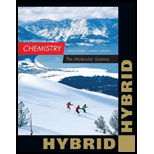
(a)
Interpretation:
Whether the given reaction is zeroth, first-, or second-order by using the units of the rate constant has to be determined.
Concept Introduction:
(a)
Explanation of Solution
The rate constant of the reaction is
(b)
Interpretation:
The mass of azomethane remains after
Concept Introduction:
The integrated rate equation for first order reaction is given below.
Where,
Half-life of a first order reaction can be calculated using following equation.
(b)
Answer to Problem 100QRT
The mass of azomethane remains after
Explanation of Solution
Given,
The mass of azomethane remains after
The concentration of azomethane remains is
Therefore the mass of azomethane remains can be calculated as follows,
The mass of azomethane remains after
(c)
Interpretation:
The time taken for the azomethane to drop from
Concept Introduction:
Refer to part (b).
(c)
Answer to Problem 100QRT
The time taken for the concentration to drop from
Explanation of Solution
Given,
The time taken for the azomethane to drop from
The time taken for the concentration to drop from
(d)
Interpretation:
The mass of nitrogen found in the flask after
Concept Introduction:
Refer to part (b).
(d)
Answer to Problem 100QRT
The mass of nitrogen remaining in the flask after
Explanation of Solution
Mass of
Here mass is proportional to concentration. So instead of concentration mass can be taken for calculation as follows,
Amount of
Hence mass of nitrogen remaining in the flask can be calculated as follows,
The mass of nitrogen remaining in the flask after
Want to see more full solutions like this?
Chapter 11 Solutions
Chemistry: The Molecular Science, Hybrid Edition (with OWLv2 24-Months Printed Access Card)
- At 573 K, gaseous NO2(g) decomposes, forming NO(g) and O2(g). If a vessel containing NO2(g) has an initial concentration of 1.9 102 mol/L, how long will it take for 75% of the NO2(g) to decompose? The decomposition of NO2(g) is second-order in the reactant and the rate constant for this reaction, at 573 K, is 1.1 L/mol s.arrow_forwardOne possible mechanism for the decomposition of nitryl chloride, NO2CI, is What is the overall reaction? What rate law would be derived from this mechanism? What effect does increasing the concentration of the product NO2 have on the reaction rate?arrow_forwardNitryl fluoride is an explosive compound that can be made by oxidizing nitrogen dioxide with fluorine: 2 NO2(g) + F2(g) → 2 NO2F(g) Several kinetics experiments, all done at the same temperature and involving formation of nitryl fluoride, are summarized in this table: Write the rate law for the reaction. Determine what the order of the reaction is with respect to each reactant and each product. Calculate the rate constant k and express it in appropriate units.arrow_forward
- The Raschig reaction produces the industrially important reducing agent hydrazine, N2H4, from ammonia, NH3, and hypochlorite ion, OCl−, in basic aqueous solution. A proposed mechanism is Step 1: Step 2: Step 3: What is the overall stoichiometric equation? Which step is rate-limiting? What reaction intermediates are involved? What rate law is predicted by this mechanism?arrow_forwardIsomerization of CH3NC occurs slowly when CH3NC is heated. CH3NC(g) CH3CN(g) To study the rate of this reaction at 488 K, data on [CH3NC] were collected at various times. Analysis led to the following graph. (a) What is the rate law for this reaction? (b) What is the equation for the straight line in this graph? (c) Calculate the rate constant for this reaction. (d) How long does it take for half of the sample to isomerize? (e) What is the concentration of CH3NC after 1.0 104 s?arrow_forwardFor a reaction involving the decomposition of a hypothetical substance Y, these data are obtained: Determine the order of the reaction. Write the rate law for the decomposition of Y. Calculate k for the experiment above.arrow_forward
- Express the rate of the reaction 2N2O(g)2N2(g)+O2(g) in terms of (b) [ N2O ] (a) [ O2 ]arrow_forwardThe decomposition of iodoethane in the gas phase proceeds according to the following equation: C2H5I(g)C2H4(g)+HI(g) At 660. K, k = 7.2 104 sl; at 720. K, k = 1.7 102 sl. What is the value of the rate constant for this first-order decomposition at 325C? If the initial pressure of iodoethane is 894 torr at 245C, what is the pressure of iodoethane after three half-lives?arrow_forwardDefine stability from both a kinetic and thermodynamic perspective. Give examples to show the differences in these concepts.arrow_forward
 Chemistry: The Molecular ScienceChemistryISBN:9781285199047Author:John W. Moore, Conrad L. StanitskiPublisher:Cengage Learning
Chemistry: The Molecular ScienceChemistryISBN:9781285199047Author:John W. Moore, Conrad L. StanitskiPublisher:Cengage Learning Chemistry & Chemical ReactivityChemistryISBN:9781337399074Author:John C. Kotz, Paul M. Treichel, John Townsend, David TreichelPublisher:Cengage Learning
Chemistry & Chemical ReactivityChemistryISBN:9781337399074Author:John C. Kotz, Paul M. Treichel, John Townsend, David TreichelPublisher:Cengage Learning ChemistryChemistryISBN:9781305957404Author:Steven S. Zumdahl, Susan A. Zumdahl, Donald J. DeCostePublisher:Cengage Learning
ChemistryChemistryISBN:9781305957404Author:Steven S. Zumdahl, Susan A. Zumdahl, Donald J. DeCostePublisher:Cengage Learning
 Chemistry: An Atoms First ApproachChemistryISBN:9781305079243Author:Steven S. Zumdahl, Susan A. ZumdahlPublisher:Cengage Learning
Chemistry: An Atoms First ApproachChemistryISBN:9781305079243Author:Steven S. Zumdahl, Susan A. ZumdahlPublisher:Cengage Learning Chemistry & Chemical ReactivityChemistryISBN:9781133949640Author:John C. Kotz, Paul M. Treichel, John Townsend, David TreichelPublisher:Cengage Learning
Chemistry & Chemical ReactivityChemistryISBN:9781133949640Author:John C. Kotz, Paul M. Treichel, John Townsend, David TreichelPublisher:Cengage Learning





